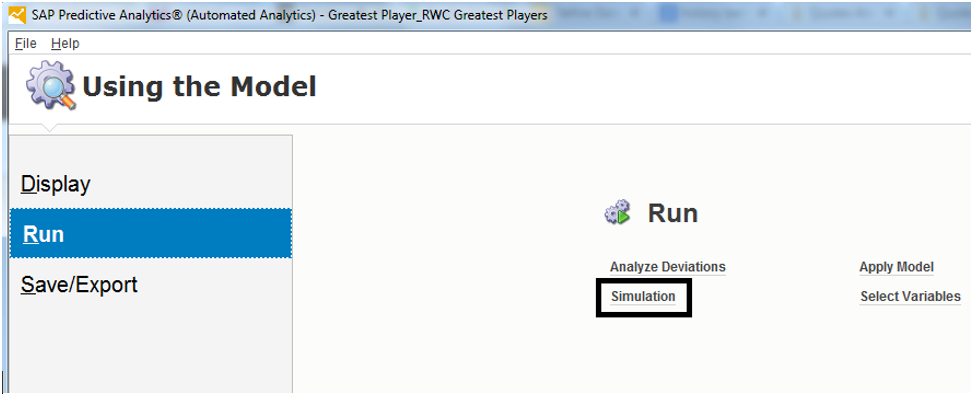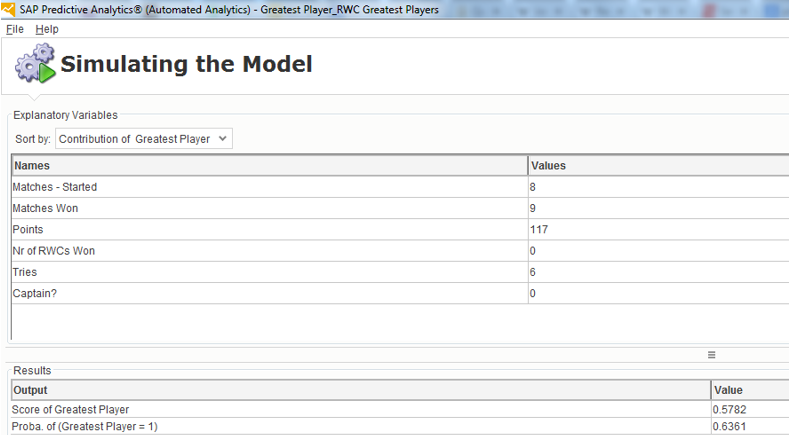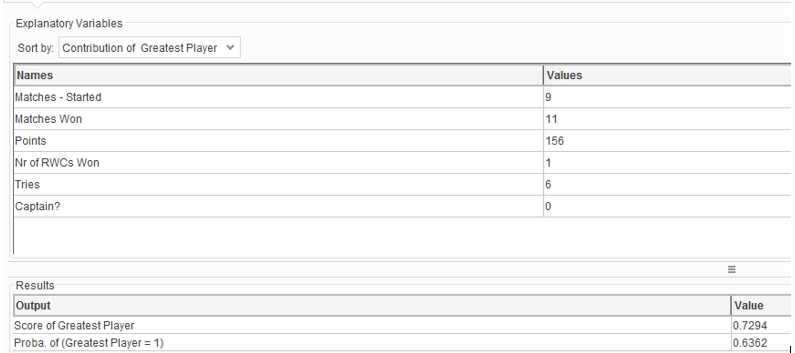
- SAP Community
- Products and Technology
- Technology
- Technology Blogs by SAP
- To Be or not to Be...a Rugby World Cup 2015 Star!
- Subscribe to RSS Feed
- Mark as New
- Mark as Read
- Bookmark
- Subscribe
- Printer Friendly Page
- Report Inappropriate Content
This is the second part of my blog related to predictive & rugby.
In part 1, I explained the data preparation, the creation of the predictive model and the findings. Part 3 details the application of the predictive model to new data (RWC 2015 players).
The tragedy of modern rugby players is that despite their amazing performances, few of them will be remembered on the long-run.
didier.mazoue pointed my attention on the fact that a performance data set is not capturing 100% of the reasons why certain players become legends.
Call it charisma, leadership, fair-play, beauty or sometimes evil character traits (this is rugby after all!), but its participates to our collective memories.
Sebastien “Caveman” Chabal is a retired French player that was featured a lot in the sport medias over the past years.
I will first test my model on that player, to see if its fame is coming from its performance or its from its "beardy" look :wink:

I fill the 6 variables that are part of the model, using the data I collected.

The score I get is quite low (0,2 out of 1), which means that Mr. Chabal's popularity will probably never exceed France’s boundaries in the coming decades.
Now the fun part starts - trying to predict the future :cool:
I am going to place a bet on Jonathan Sexton becoming an all-star of the next world cup, so as to please my Dublin colleagues :wink: and also because I feel he deserves it!
Let’s back this up with some degree of rationale:
- Jonathan Sexton was nominated for the player of the year in 2014. The guy is young and talented.
- Ireland is the third nation in the world as per the IRB rankings.
- Google and the Irish Times seems to agree with me (oh, that would be a tie with Paul O’Connell, right?)
Let’s be positive and say Ireland will reach the semi-finals (I don’t want to know what that would mean for France :sad: ).
If such is the case, Jonathan Sexton will play 6 additional matches, win 5 of them and unfortunately lose the 6th one.
Let’s pretend he will score an average 8 points per match, that means a total of 48 points.
Here are its current RWC stats:
- 2 matches started in the field
- 21 points scored
- 4 matches won (with the team).
- He never scored a try during a Rugby World Cup.
- He is not a captain and will not be this year - this goes to Paul O’Connell
- He never won the Rugby World Cup.

Jonathan Sexton’s stats after the World Cup would be
- 8 matches started in the field
- 69 points scored (in the two RWC editions)
- 9 matches won (with the team).
- Let’s assume he would do 3 tries.
- He is not a captain and will not be this year .
- Ireland (and him) would not win the Rugby World Cup (in that scenario)

There is slightly one chance out of two that Jonathan Sexton will become one of my greatest players of all time for the rugby world cup.
Let’s now unleash fantasy and explore different scenarios.
- Two time more points per game. It means Mr Sexton would reach 117 points in total, 16 points per game. The variation of the score is very little (0,53).

- Let’s say he is also scoring two time more tries. The score becomes better (0,58) but not there yet.

- Total Fantasy Scenario (or…could that be :???: ? that's the glorious uncertainty in sports). Ireland is beating England and New Zealand and becoming the world champion for the next four years. Mr Sexton is a key artisan of the victory with 15 points per game and 6 tries overall. Go Ireland! After such a successful campaign, I will certainly do some room for Jonathan Sexton in my personal rugby hall of fame!

Thanks for reading this blog post, I hope you have enjoyed it and please comment on who you think will be the next RWC 2015 rock-stars :cool:
I wish all of you a nice summer break, see you on SCN in September!
Antoine
- SAP Managed Tags:
- SAP Predictive Analytics
You must be a registered user to add a comment. If you've already registered, sign in. Otherwise, register and sign in.
-
ABAP CDS Views - CDC (Change Data Capture)
2 -
AI
1 -
Analyze Workload Data
1 -
BTP
1 -
Business and IT Integration
2 -
Business application stu
1 -
Business Technology Platform
1 -
Business Trends
1,658 -
Business Trends
91 -
CAP
1 -
cf
1 -
Cloud Foundry
1 -
Confluent
1 -
Customer COE Basics and Fundamentals
1 -
Customer COE Latest and Greatest
3 -
Customer Data Browser app
1 -
Data Analysis Tool
1 -
data migration
1 -
data transfer
1 -
Datasphere
2 -
Event Information
1,400 -
Event Information
66 -
Expert
1 -
Expert Insights
177 -
Expert Insights
293 -
General
1 -
Google cloud
1 -
Google Next'24
1 -
Kafka
1 -
Life at SAP
780 -
Life at SAP
13 -
Migrate your Data App
1 -
MTA
1 -
Network Performance Analysis
1 -
NodeJS
1 -
PDF
1 -
POC
1 -
Product Updates
4,577 -
Product Updates
340 -
Replication Flow
1 -
RisewithSAP
1 -
SAP BTP
1 -
SAP BTP Cloud Foundry
1 -
SAP Cloud ALM
1 -
SAP Cloud Application Programming Model
1 -
SAP Datasphere
2 -
SAP S4HANA Cloud
1 -
SAP S4HANA Migration Cockpit
1 -
Technology Updates
6,873 -
Technology Updates
417 -
Workload Fluctuations
1
- Which Embedding Model should I use with my Corporate LLM? in Technology Blogs by SAP
- It's Christmas! Ollama+Phi-2 on SAP AI Core in Technology Blogs by SAP
- GenAI Mail Insights - Leveraging the generative AI hub in SAP AI Core to improve customer support in Technology Blogs by SAP
- Enhancing Business Excellence with SAP Signavio's Journey-to-Process Analytics Solution in Technology Blogs by SAP
- UI5con 2023 – UI5 Web Component in Technology Blogs by Members
| User | Count |
|---|---|
| 34 | |
| 25 | |
| 12 | |
| 7 | |
| 7 | |
| 6 | |
| 6 | |
| 6 | |
| 5 | |
| 4 |